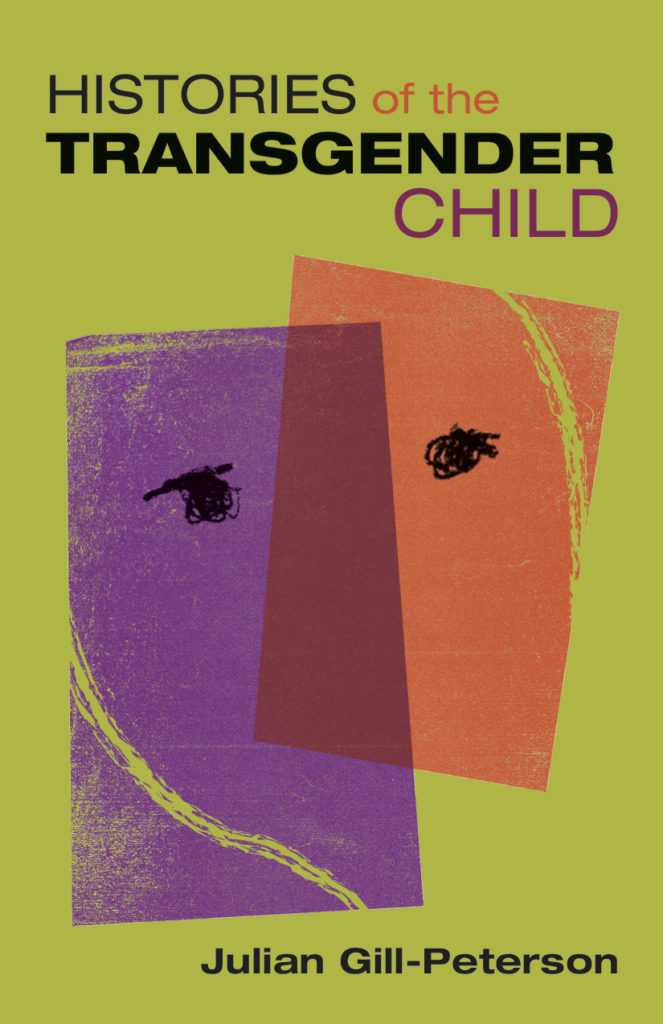Julian Gill-Peterson
Histories of the Transgender Child is the first to break down the dominant myth that today’s trans kids are a brand new generation. Looking back at the twentieth century, it not only argues that trans children have a documentable history, but that they were central to how medical science made sex and gender alterable forms. Medical science reconceived of sex and gender as plastic—receptive to changes in form—by experimenting on trans and intersex infants and children, whose growth and development seemed to them to incarnate plasticity itself. Making sex and gender plastic was part of a broader racial logic in medical science and the resulting medical model that has pathologized trans people also built in an exclusion of black trans and trans of color kids, who were rejected by doctors for being, in their eyes, “not plastic enough” to receive care.

NOTCHES: What drew you to this topic, and what are the questions do you still have?
Gill-Peterson: Watching the overwhelming rise in the visibility of trans people over the past decade, I have been angered and saddened by the increasing degree to which children have become the targets of hateful and sometimes violent anti-trans forces. I also found myself bothered by the mystique cloaking trans kids from allies, who largely seemed to agree that it was unprecedented for children to be trans and, therefore, it was unclear how to defend and affirm them. This got me curious in what sorts of histories had yet to be told and how they could combat the dominant way people talk about trans kids today. I found my way into this research through whispers in the archive of trans medicine, subtle hints that there were children fifty, sixty, or more years ago who not only identified as trans, but were interacting with doctors and, in some cases, getting access to hormones and other forms of support. From there, I took a deep dive into medical archives where I suspected I would have the highest chance of finding traces of trans kids.
NOTCHES: This book is about histories of gender and sexuality, but what other themes does it speak to?
Gill-Peterson: One of my aims in the book is to show how sex and gender are derived out of larger racial projects. Medical science redefined sex and gender over the twentieth as phenotypes, but ones that had to be grown out of an original plasticity, and so were sensitive to alteration. In the early twentieth century, when most of the life sciences were explicitly eugenic, this resulted in the sorting of sexed morphologies through racial typologies, where white Europeans were seen as the most sexually differentiated of humans, and colonized peoples and people of color were declared morphologically more “mixed” in their sex. Understanding the racial projects of medicine animating sex and gender helps us better understand the racist histories built into medical models like the one that pathologizes trans people and continues to restrict trans people of color’s access to care.
NOTCHES: How did you research the book? (What sources did you use, were there any especially exciting discoveries, or any particular challenges, etc.?)
Gill-Peterson: The book is based in a number of medical archives from around the US, with a particular focus on the Johns Hopkins Hospital in Baltimore. I turned to the medical archive in order to critique its hegemony in producing knowledge about trans people. Finding trans children in an archive that was by the design of its architects—doctors—not meant to record or recognize their humanity, was challenging. The further you go back in the twentieth century, too, the fewer recognizable terms there are for transness that can locate people in the archive. The book ultimately comes out of many exciting moments in the archive where a hunch paid off and I found a way to identify groupings of trans kids through the idioms or narrative conventions particular to that era. The most elusive kind of archival material, then, was anything that might actually yield the perspective of trans kids themselves, rather than what doctors said about them. One of the most rewarding moments for me was finding a set of letters written to doctors by trans kids in the 1960s and 1970s, where they spoke first hand and in their own words about their lives.
NOTCHES: Whose stories or what topics were left out of your book and why? What would you include had you been able to?
Gill-Peterson: The book focuses on the medical archive to critique and challenge its power in narrating trans history, but that focus means that most of what falls outside of that archive is not included. Though there are important moments where I emphasize the lives of trans kids outside of the medical context, there are countless other histories and experiences that had no interaction with medicine that are not part of the book’s scope. Because this is the first book on the history of trans children, I hope we see many more in the future that differ from mine—we need more histories that diversify and enrich our understanding of the trans past. There simply is no singular narrative to trans history or the history of trans kids.
NOTCHES: Did the book shift significantly from the time you first conceptualized it?
Gill-Peterson: The book shifted in pace with my archival research because I had no idea what kinds of histories for trans kids I would find when I set out, given that none had ever been written about before. The broader argument of the book, that sex and gender are directly dependent on how we conceptualize the plasticity of children, is one I wanted to develop going into the project. But the actual texture of the lives and experiences of the trans kids I write about, which accumulated over its research, transformed the final form that the book has taken. In many ways—and this is part of what I write about in the preface—I feel transformed by some of the children that I write about. Though I had to pseudonymize them and omit some of the details of their life to protect their privacy, the book feels to me, in tone and ethos if not also in argument and analysis, indebted to their incredible knowledge, persistence, and ingenuity.
NOTCHES: How did you become interested in the history of sexuality?
Gill-Peterson: As a queer and trans person—but also as a nerd first and foremost—I’ve been fascinated by the history of sexuality for as long as I’ve been fascinated by history. Not so much out of a desire to “trace back origins” or to identify with people like myself in the past, but to problematize the very terms in which we have come to understand ourselves as belonging to queer and trans categories, and to challenge the forms of political dominant that have long plagued queer and trans people through controlling the production of knowledge about them.
I first learned that all this was a field of study in my undergrad degree, when I was lucky to be mentored by an amazing historian of sexuality, Heather Murray. One thing that has stuck with me since then is that there is so much work to be done in the field. Queer and trans histories, in particular, have been suppressed, erased, and forgotten, leaving a massive amount of vital work to problematize that enduring lack of history. This is part of the driving force behind my scholarship, but also a source of immense pleasure as I pursue research. There is always more to be done. Not to straightforwardly recover the past, but to read into its wondrous opacity and find ourselves unmade by it.
NOTCHES: How do you see your book being most effectively used in the classroom? What would you assign it with?
Gill-Peterson: My hope is that the book’s chronologically divided chapters makes them usefully individually when necessary, in courses that touch on trans history, or the history of sex, gender, and sexuality. But I also hope that its theoretical work showing how gender was made out of a racial project places it on syllabi in a range of gender studies, queer studies, and other intersectional courses. I think it would pair well with a range of scholarship, not just in trans history, but earlier lesbian and gay histories of sexual inversion and cross-gendered life whose findings I challenge. Because I frame the histories in the book to critique and reframe the political exigencies of the present day, I would also assign the book alongside contemporary cultural materials about trans kids, to see how these histories change the terms of our broader conversation about trans childhood today.
NOTCHES: Why does this history matter today?
Gill-Peterson: Trans people are under attack. What’s more, trans children have become preferred targets of anti-trans forces. We already expect children to be, to some degree, fluid, malleable, and unfinished. And so anti-trans agitators have figured out that they can more easily deny the very reality of trans kids than they can for adults. In this moment of political emergency, we need history to interrupt the inertia we feel in facing down these attackers. Being treated as new or unprecedented is a form of political suppression, and trans kids bear much of the weight of that myth right now. To stand against anti-trans forces with a defiant no, to point out that trans kids have long existed and will continue to exist, can be reinforced with the resources of historical depth that trans history offers. I hope that this history spurs not so much identification with the past as a defense of trans kids in the present, a loud and affirmative desire that trans kids be in the world, that we not only welcome them, but wish for them and want them to exist.
NOTCHES: Your book is published, what next?
Gill-Peterson: I said earlier that my book’s focus on the medical archive left out many other stories that didn’t involve medicalization. So in my new book project I am turning to the domain of DIY (do-it-yourself), looking at the various ways that trans people have found survival and flourishing without the sanction and limitations of official medicine. I am interested in seeing what happens if I tell trans history since the 1940s without using the medical archive, but instead centering the voices of those most marginalized by it, poor folks and trans people of color, whose lives were more often DIY through and through. This research will use DIY as a lens to make the point that the real source of knowledge about transness has never been medical science at all, but has always been in the hands of trans people themselves.
 Julian Gill-Peterson is Assistant Professor of English and Gender, Sexuality, and Women’s Studies at the University of Pittsburgh. In 2018 they are also an ACLS Fellow. Julian is the author of Histories of the Transgender Child (2018). They are currently at work on a book project entitled Gender Underground: A History of Trans DIY.
Julian Gill-Peterson is Assistant Professor of English and Gender, Sexuality, and Women’s Studies at the University of Pittsburgh. In 2018 they are also an ACLS Fellow. Julian is the author of Histories of the Transgender Child (2018). They are currently at work on a book project entitled Gender Underground: A History of Trans DIY.

NOTCHES: (re)marks on the history of sexuality is licensed under a Creative Commons Attribution-NonCommercial-NoDerivatives 4.0 International License.
Based on a work at www.notchesblog.com.
For permission to publish any NOTCHES post in whole or in part please contact the editors at NotchesBlog@gmail.com




